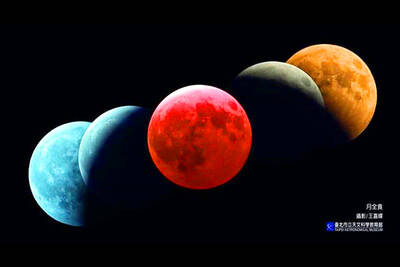As the summer heat continues, consumption of refreshing drinks is on the up, something that holds especially true for local speciality zhenzhu naicha, or pearl milk tea.
With the increased consumption of pearl tea come worries about weight gain.
According to a CNA report, a study by Taipei Medical University Hospital shows that a 0.7 liter glass of full-sugar pearl milk tea contains 393 calories, equal to the amount of calories in one and a half bowls of rice, with one bowl containing 280 calories.
Taipei Medical University Hospital nutritionist Chen Chiao-ming (
"To burn off a glass of pearl milk tea, with its nearly 400 calories, one would have to jog for at least one-and-a-half hours," Chen added.
Other popular thirst-quenchers are also high in calories: one 0.7l -liter glass of "pudding milk tea" contains 325 calories, while a "black tea latte" contains 320 calories and a glass of green or black pearl tea contains 276 calories.
The study also suggests that drinks made from fruit juices do not necessarily lower the calorie intake, as drinking a 0.7l liter glass of papaya or avocado milk contains 295 and 296 calories respectively.
Chen went on to say that people who are fond of drinking iced beverages, but do not want to put on weight, should instead choose to drink low-calorie green or black tea and eat coconut flesh, which is rich in fiber.

Three batches of banana sauce imported from the Philippines were intercepted at the border after they were found to contain the banned industrial dye Orange G, the Food and Drug Administration (FDA) said yesterday. From today through Sept. 2 next year, all seasoning sauces from the Philippines are to be subject to the FDA’s strictest border inspection, meaning 100 percent testing for illegal dyes before entry is allowed, it said in a statement. Orange G is an industrial coloring agent that is not permitted for food use in Taiwan or internationally, said Cheng Wei-chih (鄭維智), head of the FDA’s Northern Center for

LOOKING NORTH: The base would enhance the military’s awareness of activities in the Bashi Channel, which China Coast Guard ships have been frequenting, an expert said The Philippine Navy on Thursday last week inaugurated a forward operating base in the country’s northern most province of Batanes, which at 185km from Taiwan would be strategically important in a military conflict in the Taiwan Strait. The Philippine Daily Inquirer quoted Northern Luzon Command Commander Lieutenant General Fernyl Buca as saying that the base in Mahatao would bolster the country’s northern defenses and response capabilities. The base is also a response to the “irregular presence this month of armed” of China Coast Guard vessels frequenting the Bashi Channel in the Luzon Strait just south of Taiwan, the paper reported, citing a

UNDER PRESSURE: The report cited numerous events that have happened this year to show increased coercion from China, such as military drills and legal threats The Chinese Communist Party (CCP) aims to reinforce its “one China” principle and the idea that Taiwan belongs to the People’s Republic of China by hosting celebratory events this year for the 80th anniversary of the end of World War II, the “retrocession” of Taiwan and the establishment of the UN, the Mainland Affairs Council (MAC) said in its latest report to the Legislative Yuan. Taking advantage of the significant anniversaries, Chinese officials are attempting to assert China’s sovereignty over Taiwan through interviews with international news media and cross-strait exchange events, the report said. Beijing intends to reinforce its “one China” principle

A total lunar eclipse, an astronomical event often referred to as a “blood moon,” would be visible to sky watchers in Taiwan starting just before midnight on Sunday night, the Taipei Astronomical Museum said. The phenomenon is also called “blood moon” due to the reddish-orange hue it takes on as the Earth passes directly between the sun and the moon, completely blocking direct sunlight from reaching the lunar surface. The only light is refracted by the Earth’s atmosphere, and its red wavelengths are bent toward the moon, illuminating it in a dramatic crimson light. Describing the event as the most important astronomical phenomenon